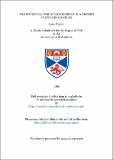Files in this item
The potential for introgression in a British polyploid complex
Item metadata
| dc.contributor.advisor | Ingram, Ruth | |
| dc.contributor.author | Taylor, Lynn | |
| dc.coverage.spatial | 294 p. | en_US |
| dc.date.accessioned | 2018-06-18T14:10:06Z | |
| dc.date.available | 2018-06-18T14:10:06Z | |
| dc.date.issued | 1985 | |
| dc.identifier.uri | https://hdl.handle.net/10023/14207 | |
| dc.description.abstract | The potential for introgression in the British Senecio polyploid complex was investigated using numerical taxonomic methods. It has been suggested that introgression of the introduced Mediterranean diploid S. squalidus L. into the native British tetraploid species S. vulgaris var. vulgaris (non-radiate) has given rise to the inland radiate morph S. vulgaris var. hibernicus Syme. The research reported in this thesis falls into three main sections. The first part describes the results of a crossing program to determine the interfertility relationships of the British Senecio species, S. vulgaris var. vulgaris, vulgaris var. hibernicus, S. vulgaris var. denticulatus, S. viscosus, S. squalidus, S. vernalis, and S. cambrensis. Interspecific hybrids at the diploid, triploid and tetraploid levels were formed. If was found that hybrid fertility was largely dependent on genomic balance. The phenetic similarities of the interspecific hybrids and the parental species were examined by multivariate analysis of 64 morphological characters, using both cluster analysis and ordination methods. The results obtained suggest that radiate S. vulgaris may have arisen via non-reduction of a S. squalidus gamete. The backcross progeny of a tetraploid S. vulgaris var. vulgaris x S. sgualidus hybrid were phenetically close to radiate S. vulgaris. However, F2 progeny of naturally occurring triploid vulgaris x S. squalidus and S. x subnebrodensis hybrids were found to have chromosome numbers between the diploid and sub-triploid levels. The diploid F2 hybrids were morphologically indistinguishable from S. squalidus. The third part of the thesis describes the results of a morphometric analysis of the geographic variation in radiate and non-radiate S. vulgaris, and S. squalidus in central Scotland. It was found that the interpopulation differentiation in both radiate and non-radiate S. vulgaris was correlated with both the geographic distribution of radiate S. vulgaris and the longitude. In conclusion it is suggested that, although S. vulgaris var. hibernicus may have originated by introgression of S. squalidus into S. vulgaris var. vulgaris, the current potential for introgression would appear to be in other directions, from the tetraploids S. vulgaris and S. viscosus into the diploid S. squalidus. The greatest extent of gene flow, however, was found to be from radiate S. vulgaris into non-radiate S. vulqaris. | en_US |
| dc.language.iso | en | en_US |
| dc.publisher | University of St Andrews | |
| dc.subject.lcc | QK524.P7T2 | en |
| dc.subject.lcsh | Polypodiaceae | en |
| dc.title | The potential for introgression in a British polyploid complex | en_US |
| dc.type | Thesis | en_US |
| dc.contributor.sponsor | Natural Environment Research Council (NERC) | en_US |
| dc.type.qualificationlevel | Doctoral | en_US |
| dc.type.qualificationname | PhD Doctor of Philosophy | en_US |
| dc.publisher.institution | The University of St Andrews | en_US |
This item appears in the following Collection(s)
Items in the St Andrews Research Repository are protected by copyright, with all rights reserved, unless otherwise indicated.

